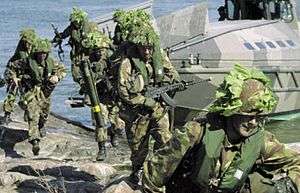Finnish Coastal Jaegers
The Finnish Coastal Jaegers (Swedish: Kustjägarna, and Finnish: Rannikkojääkärit) are the amphibious arm of the Finnish Navy. The unit consists of both regulars and conscripts, predominantly Swedish-speaking, and is located at Nyland Brigade (Uusimaa Brigade) in Dragsvik, near Ekenäs.
| Finnish Coastal Jaegers Rannikkojääkärit (Finnish) Kustjägarna (Swedish) | |
|---|---|
 Green beret with Sea Eagle's Head pin | |
| Country | |
| Branch | |
| Type | Marine commando |
| Role | Amphibious warfare, reconnaissance, unconventional warfare |
| Part of | |
| Garrison/HQ | Dragsvik, Raseborg, Finland |
| Nickname(s) | Rannarit |
| Motto(s) | Sv: "En gång kustjägare, alltid kustjägare." Fi: "Kerran rannikkojääkäri, aina rannikkojääkäri." (Once a coastal jaeger, always a coastal jaeger.) |
| Commanders | |
| Current commander | Commodore Sami Jaakkola |

Mission
The Finnish Coastal Jaegers primary role is to conduct counter attacks against enemy landings in the Finnish archipelago, an environment known for small islands and skerries. Jaegers can function independently or with the support of artillery units, including light or heavy mortars. A number of Coastal Jaeger troops receive training for unconventional warfare and reconnaissance behind enemy lines.
Selection
Conscripts are selected for training at 1. & 2. KustJK (the Coastal Jaeger companies; Swedish: 1. & 2. Kustjägarkompaniet) in Dragsvik on the basis of the physical review taken by all conscripts before they enter military service. After 6 weeks of basic training, privates are assigned to further training in the same unit if suitable or moved to another unit for other type of training. The number of jaegers trained varies per intake, but usually about 30-50% of the conscripts in the two KJKs go on to receive marine training, with approx. 40% of them selected for training as NCOs or officer candidates. The other half of KJK recruits receive training for support roles such as cooks, medics, drivers and boatsmen, for easier combat roles and may even be transferred to other units.
Conscripts are selected for NCO (Stage 1) education after 12 weeks of training. Candidates for officer training are selected during the 6-week-long Stage 1 of NCO training. About 10-20% of Stage 1 NCO candidates are sent to the Reserve Officer's School for the 16-week-long course and become officer candidates upon return to Dragsvik.
Training
The main elements of Jaeger training are combat training, weapon handling, endurance and mobility. For privates the training is 22 weeks and encompasses the fundamental elements of amphibious/marine warfare, urban operations and individual military operational specialty. NCO and officer training lasts for 46 weeks, incorporating specialised urban combat training. A Jaeger candidate is more likely to spend time marching with a heavy rucksack than doing push-ups. Marches are usually carried out with "full field equipment" (meaning 40–50 kg) and can be as long as 80–90 km. Coastal Jaegers can go with as little as 1–3 hours of sleep during a 4-day exercise.
The difference in length, quality, and intensity of training is reflected in the composition of units used for international duties. These usually consist almost exclusively of NCOs and officers.
The Green Beret
Coastal Jaegers obtain the right to wear the unit's green beret (jaeger green beret with a golden sea eagle) by reaching the required standards in shooting, running, swimming, strength, completing all major exercises and completing the beret march. The beret march is approximately 80 km in length, over which the Jaeger candidates must navigate by foot, carrying 40–45 kg of equipment. Every 5–10 km the candidates stop to complete tasks, such as medical evacuation of "wounded" soldiers, shooting, weapons handling, water crossing and map reading. At one point, candidates are put on a boat and driven to an unknown location. They must locate themselves on a map and find their way back to the route. The march has to be completed in a certain time limit to pass the beret march requirement for the green beret.
See also
- Kustjägarna, similar Swedish unit
- Kystjegerkommandoen, similar Norwegian unit
- Frømandskorpset, similar Danish unit